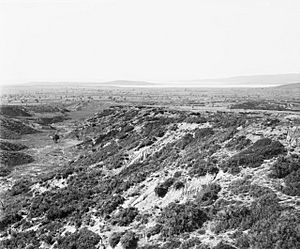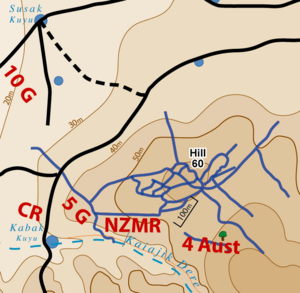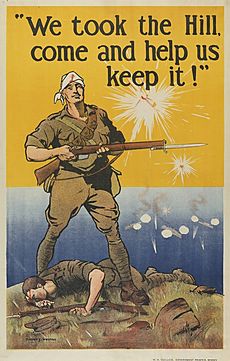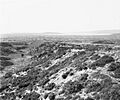Battle of Hill 60 (Gallipoli) facts for kids
Quick facts for kids Battle of Hill 60 |
|||||||
|---|---|---|---|---|---|---|---|
| Part of the Gallipoli Campaign in the Middle Eastern Theatre of the First World War | |||||||
 Kaiajik Dere and Hill 60, 1919 |
|||||||
|
|||||||
| Belligerents | |||||||
|
|||||||
| Commanders and leaders | |||||||
| Strength | |||||||
| 4,000 | Unknown | ||||||
| Casualties and losses | |||||||
| 1,100 | Unknown | ||||||
The Battle of Hill 60 was the last big attack of the Gallipoli Campaign during World War I. It happened in August 1915 on the Gallipoli peninsula in the Ottoman Empire (modern-day Turkey). The goal was to capture a small hill called Hill 60. This hill was important because it overlooked the landing areas of the Allied forces, known as Anzac and Suvla. Taking Hill 60 would have helped connect these two areas and make the Allied position stronger.
Allied forces, including soldiers from Australia, New Zealand, India, and Britain, launched two main attacks. The first was on August 21, and the second was on August 27. Even with reinforcements, the Ottoman defenders managed to hold onto the top of the hill. The battle was tough and costly for the Allies.
Contents
Why Hill 60 Was Important
Hill 60, also known as Kaiajik Aghala, was a small but very important hill. It controlled the low ground between the Allied forces at Anzac and Suvla. If the Allies could capture it, they could link up their two main landing areas. This would make it easier to move supplies and soldiers between them.
The plan was to attack Hill 60 as part of a larger push. Soldiers from several different countries were involved:
- New Zealand Mounted Rifles (about 400 men)
- Australian 4th Infantry Brigade (about 500 men)
- Two Gurkha battalions from India
- British soldiers from the Connaught Rangers and the Hampshires
The main job of capturing Hill 60 was given to the New Zealand Mounted Rifles. Other units were tasked with taking nearby water wells or creating fake attacks to distract the Ottoman forces.
The Battle Begins
The attack on Hill 60 started on August 21, 1915. The plan was to have artillery support before the soldiers advanced. However, the artillery was sent to help another attack at Suvla instead. This meant the soldiers attacking Hill 60 faced strong Ottoman defenses without much help from big guns. The Ottoman soldiers were ready for them.
The New Zealand Mounted Rifles moved forward at 3:30 AM. Some Ottoman soldiers ran from their front trenches, and the New Zealanders quickly took over these positions. By 4:00 AM, they had reached their first goal. But the Indian and Australian soldiers on their sides had not advanced as far. The Connaught Rangers, however, had captured their target: some water wells.
As the Connaught Rangers pushed past the first Ottoman trenches, they faced heavy machine gun and rifle fire from the top of the hill. Ottoman artillery also fired at them. The surviving soldiers dug in and were later replaced by the Gurkhas.
The right side of the attack, where the Australian and Hampshire soldiers were, had a hard time. They had to cross a valley that was controlled by Ottoman trenches and artillery. Many soldiers were lost, and a fire started by an artillery shell burned many wounded soldiers. By 7:00 PM, the Connaughts and New Zealanders had linked up, but there was still a gap between them and the Australian forces.
Fighting Continues
On August 22, fresh Australian soldiers from the 18th Battalion joined the attack. These soldiers were new to the fighting and not well-equipped. They attacked with only their bayonets and suffered heavy losses. Out of 750 men, 383 were killed or wounded in their early morning attack on Hill 60.
The main assault started again on August 27. The Allied forces made more progress up the hill. However, the Ottoman soldiers still held the very top. That evening, Australian Light Horse soldiers were sent in as reinforcements. One group of 75 men got lost and were caught in the open by Ottoman machine guns. Many soldiers, including their commander, were killed.
More Light Horse soldiers joined the fight. On August 28, some trenches at the top of the hill were captured. But the Ottomans held onto the crucial northern side, which looked over the Suvla area. The fighting, with attacks and counter-attacks, continued for three days. The Battle of Hill 60 finally ended on August 29, 1915.
What Happened Next
The Battle of Hill 60 was the last major attack by the Allies in the Anzac area before they left Gallipoli in December 1915. The Allies did not fully capture the top of the hill. However, some historians say that by taking the lower parts of the hill, the Allies did make their flank (side) safer and opened a link with Suvla.

The battle was very costly for the Allies. Over 1,100 soldiers were killed or wounded. The Australian 18th Battalion, for example, lost two-thirds of its soldiers in less than two weeks. One Australian soldier, Second Lieutenant Hugo Throssell, received the Victoria Cross (a very brave award) for his actions during the battle. He was the last person to receive this award on the Gallipoli peninsula.
Even though some thought the hill was fully captured, the Ottoman forces still held half of Hill 60. Later, in November, New Zealand engineers dug a tunnel under Hill 60 and set off a large mine, creating a crater. But the Allies did not occupy it. Before the Allies left Gallipoli in December, they also set off mines in their positions on Hill 60. All surviving Allied soldiers were evacuated from Gallipoli on the night of December 19-20, 1915.
Today, Hill 60 is home to the Hill 60 Commonwealth War Graves Commission Cemetery. This cemetery is a place where soldiers who died in the battle are buried and remembered.
Images for kids






